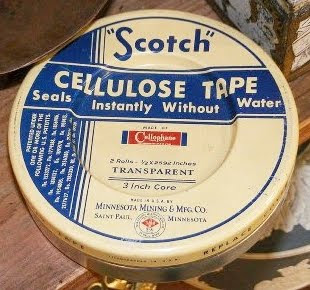
Okay, it is common knowledge that Red Green [Canadian humorist] invented Duct Tape [NOT] and not so common knowledge that Richard Drew invented transparent adhesive tape [NOT NOT].
In 1930, Scotch tape was developed by Richard G. Drew at 3M, St. Paul Minn. Originally, 3M only made sandpaper, and during testing Drew observed at a local auto bodyshop that auto painters had difficulty making clean dividing lines on two-color paint jobs. After two years of effort in the company's labs, he invented masking tape (1925), a tan paper tape with a light, pressure sensitive adhesive backing. Five years later, he invented Scotch Brand Cellulose Tape, the first waterproof, see-through, pressure-sensitive tape.
About.com...
In 1923, Richard Drew joined the 3M company located in St. Paul, Minnesota. At the time, 3M only made sandpaper. Drew was product testing 3M's Wetordry brand sandpaper at a local auto bodyshop, when he noticed that auto painters were having a hard time making clean dividing lines on two-color paint jobs. Richard Drew was inspired to invent the world's first masking tape in 1925, as a solution to the auto painters' dilemma.
Brandname Scotch:
The brandname Scotch came about while Richard Drew was testing his first masking tape to determine how much adhesive he needed to add. The bodyshop painter became frustrated with the sample masking tape and exclaimed, "Take this tape back to those Scotch bosses of yours and tell them to put more adhesive on it!" The name was soon applied to the entire line of 3M tapes.
Scotch Brand Cellulose Tape was invented five years later. Made with a nearly invisible adhesive, the waterproof transparent tape was made from: oils, resins, and rubber; and had a coated backing.
According to 3M:
Richard Drew, a young 3M engineer, invented the first waterproof, see-through, pressure-sensitive tape, thus supplying an attractive, moisture-proof way to seal food wrap for bakers, grocers, and meat packers. Drew sent a trial shipment of the new Scotch cellulose tape to a Chicago firm specializing in package printing for bakery products. The response was put this product on the market! Shortly after, heat sealing reduced the original use of the new tape. However, Americans in a depressed economy discovered they could use the tape to mend a wide variety of things like torn pages of books and documents, broken toys, ripped window shades, even dilapidated currency.





























!["Coupling" 1976 [Gum-bichromate]](http://2.bp.blogspot.com/_IoU3bEFUwWc/S69lnr9G6AI/AAAAAAAAH58/O40Gg-G6rKk/S150/COUPLING+3.jpg)








No comments:
Post a Comment